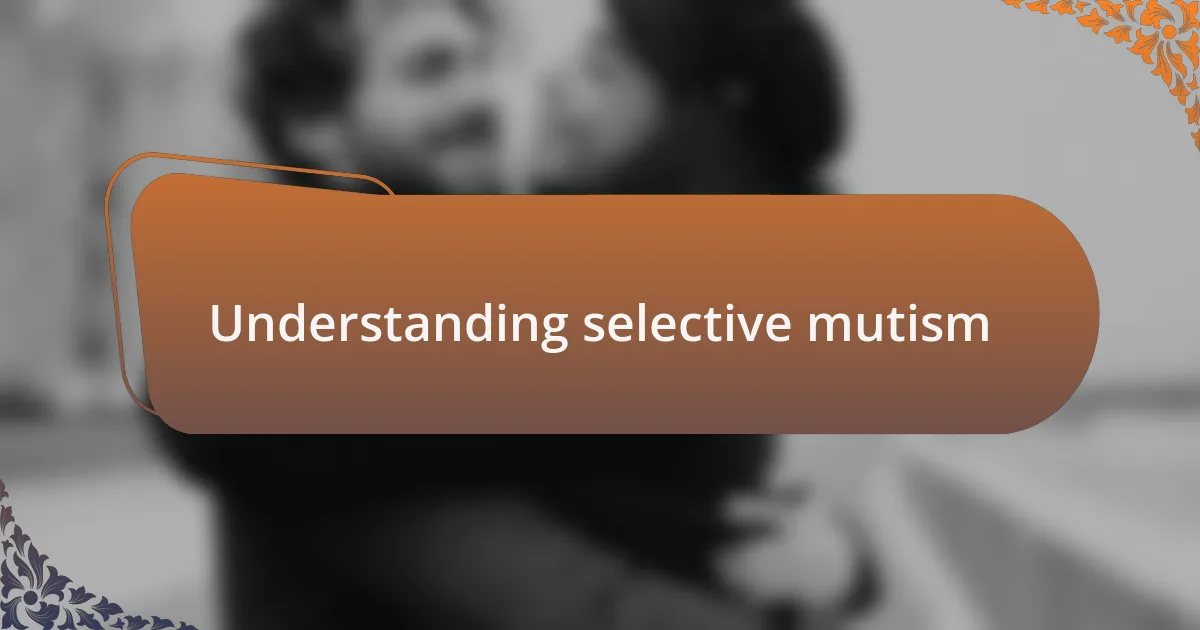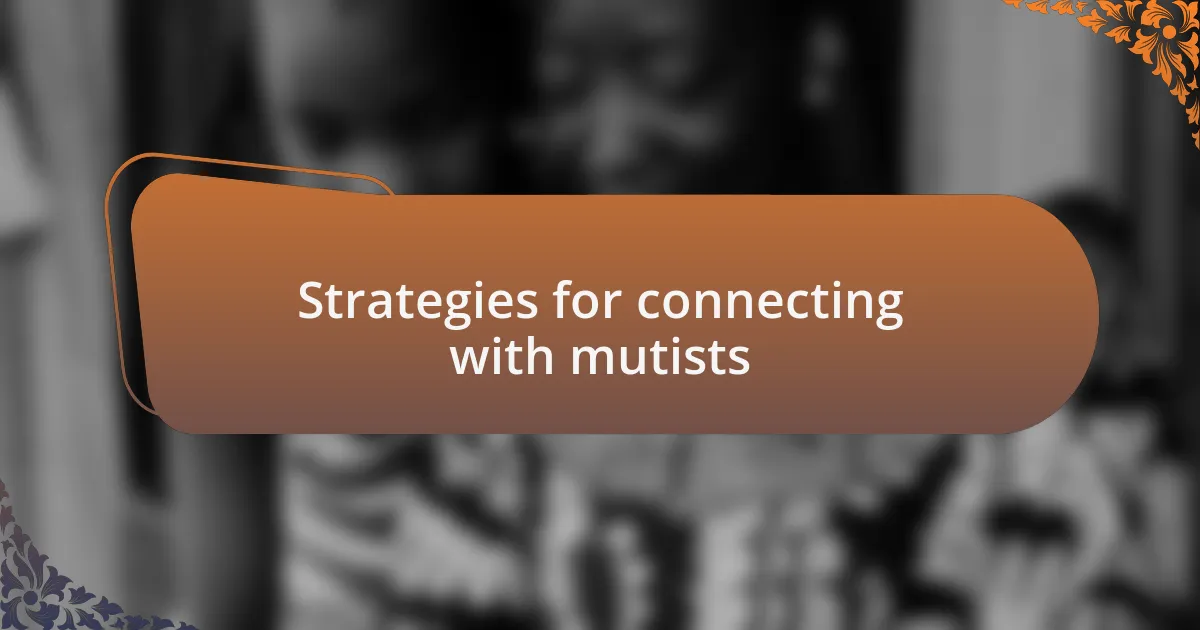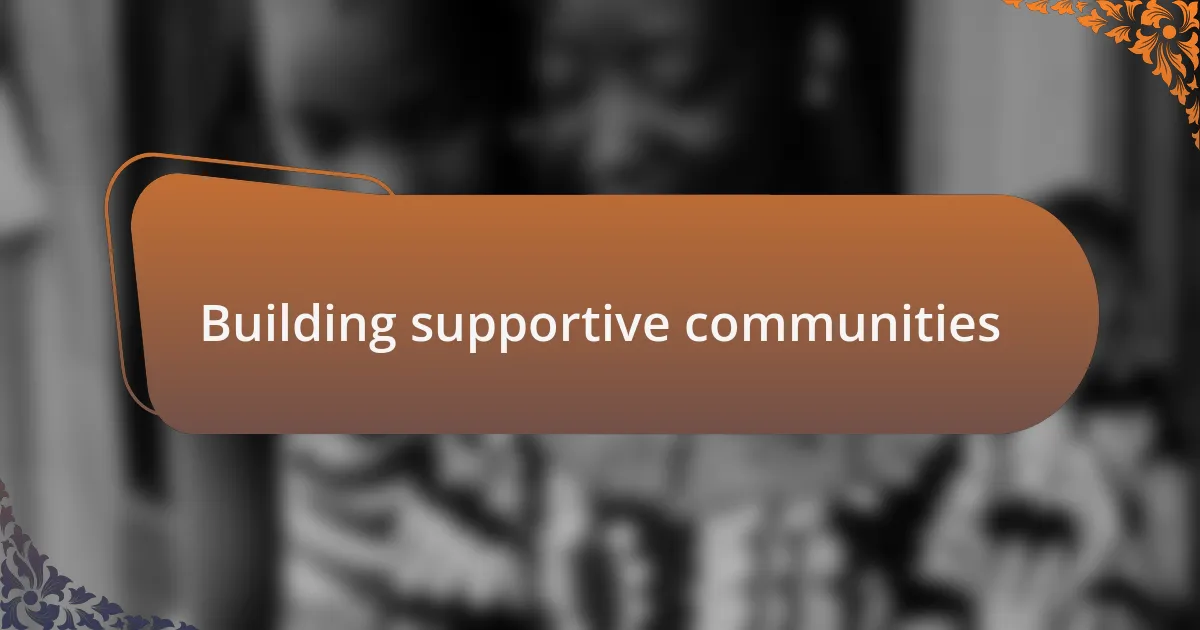Key takeaways:
- Selective mutism is an anxiety disorder in children characterized by an inability to speak in certain social situations, often due to fear of judgment.
- Raising awareness about selective mutism fosters understanding and compassion, helping to combat stigma and isolation.
- Effective strategies for connecting with children experiencing selective mutism include creating comfortable environments, using visual aids, and involving trusted peers.
- Building supportive communities through listening, safe expression, and shared activities encourages confidence and connection for those affected by selective mutism.

Understanding selective mutism
Selective mutism is a complex anxiety disorder that primarily affects children, causing them to be unable to speak in certain social situations despite having the ability to communicate verbally in more comfortable settings. I remember the first time I encountered a child who exhibited this behavior. Their eyes darted around the room, filled with unspoken words, and I couldn’t help but wonder what was going on inside their mind. It’s heartbreaking to think that something as fundamental as speaking can be so daunting for them.
At its core, selective mutism is often rooted in a fear of judgment or negative evaluation from peers or adults. I once spoke with a young girl who shared her feelings of being overwhelmed by the attention when she was called upon in class. It struck me how powerful the pressure of expectation can be. Have you ever felt that knot in your stomach before speaking in a group? It’s a familiar feeling, but for those with selective mutism, it can feel insurmountable.
Understanding selective mutism goes beyond just recognizing its symptoms; it involves empathy towards those living with it. I’ve noticed that creating a safe space where individuals feel understood and accepted can often lead to gradual improvement in their willingness to communicate. Can you imagine how liberating it would be for a child to express themselves freely? My experience tells me that patience and support can be transformative in the journey towards overcoming these barriers.

Importance of selective mutism awareness

Importance of selective mutism awareness
Raising awareness about selective mutism is essential because it fosters understanding and compassion in communities. I often think about the times when I witnessed adults dismissing a child’s silence as mere shyness, unaware of the deeper struggles at play. This lack of awareness can lead to feelings of isolation for both the children and their families, making it crucial to educate others about the condition.
When we shine a light on selective mutism, we challenge stigma and create a more inclusive environment for those affected. I recall a workshop I attended where parents shared their experiences. It was both enlightening and heartbreaking to hear their stories, as they articulated the loneliness that often accompanies their child’s condition. Have you ever felt your heart ache for someone who just wants to be heard? That’s precisely what these individuals experience.
Ultimately, awareness empowers advocacy. Knowing how to support someone with selective mutism can change lives. In my conversations with educators, I’ve seen firsthand how simple strategies can make a world of difference, like providing alternatives to verbal communication. Isn’t it powerful to think that by simply adjusting our approach, we can help these children find their voices?

Strategies for connecting with mutists
Connecting with individuals experiencing selective mutism requires patience and understanding. I recall a moment when I simply sat beside a child who often remained silent, engaging them with activities they enjoyed. By creating a comfortable space without pressure to speak, I found that the child began to express themselves through gestures and drawings, which opened new avenues for communication.
One effective strategy is to use stories or visual aids. I once introduced a picture book during a quiet reading corner session. As I read, I noticed a child’s eyes lighting up at the illustrations; eventually, they shared their thoughts through nods and smiles, guiding me to introduce a dialogue. This approach underscores the importance of fostering connections through shared experiences and interests.
Another essential strategy is to involve trusted peers in the process. I observed that when a familiar friend accompanied a shy child to group activities, there was a noticeable shift in comfort levels. This bond provided a safety net that eased anxiety, making interactions more enjoyable. Have you ever considered how a single friendly face can transform an entire experience? It’s remarkable how these little connections can lead to bigger breakthroughs.

Building supportive communities
I’ve found that building supportive communities often begins with a simple act of listening. I remember a group gathering where one member barely spoke, but when others shared their experiences, I could see their shoulders relax. It made me wonder: how powerful is it to be simply heard? Those moments of silent acknowledgment foster deep connections that words sometimes can’t convey.
Another facet of community building is creating safe spaces for expression. I once participated in an art therapy session designed specifically for those with selective mutism. It was incredible to see participants using colors and shapes to express emotions that they struggled to voice. Isn’t it fascinating how creativity can bridge the gap when silence feels overwhelming?
Additionally, I believe in the power of shared activities. In one memorable workshop, we all took part in a cooking class. Engaging our senses through cooking turned out to be a profound way to bond. It made me reflect: could the joy of creating something together actually inspire confidence? From playful laughter to quiet moments of reflection, those shared experiences became the heart of our community, making everyone feel included and valued.